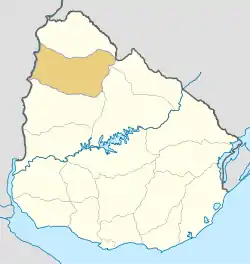Salto Department | |
|---|---|
 Flag  Coat of arms | |
 Location of Salto Department and its capital | |
| Coordinates (Salto): 31°23′S 57°57′W / 31.383°S 57.950°W | |
| Country | |
| Capital of Department | Salto |
| Government | |
| • Intendant | Andrés Lima |
| • Ruling party | Frente Amplio |
| Area | |
| • Total | 14,163 km2 (5,468 sq mi) |
| Population (2011 census) | |
| • Total | 124,878 |
| • Density | 8.8/km2 (23/sq mi) |
| Time zone | UTC-3 (UYT) |
| ISO 3166 code | UY-SA |
| Website | salto.gub.uy |
Salto Department (Spanish pronunciation: [ˈsalto]) is a department of the northwestern region of Uruguay. It has an area of 14,163 km2 (5,468 sq mi) and a population of 124,878. Its capital is the city of Salto. It borders Artigas Department to its north, Paysandú Department to its south, the departments of Rivera and Tacuarembó to its east and has the Río Uruguay flowing at its west, separating it from Argentina.
History
The first division of the Republic in six departments happened on 27 January 1816. Two more departments were formed later in that year. At the time, Paysandú Department included all the territory north of the Río Negro, which included the actual departments of Artigas, Rivera, Tacuarembó, Salto, Paysandú and Río Negro. On 17 June 1837 a new division of Uruguay was made and the department of Salto was created including the actual Artigas Department. Its final borders were defined on 1 October 1884, when the Artigas Department was separated from Salto by the Act of Ley Nº 1854.
Demographics
At the 2011 census, Salto Department had a population of 124,878 (61,071 male and 63,807 female) and 42,486 households.[2]
Demographic data for Salto Department in 2010:
- Population growth rate: 0.552%
- Birth Rate: 17.32 births/1,000 people
- Death Rate: 8.26 deaths/1,000 people
- Average age: 29.0 (27.6 male, 30.3 female)
- Life Expectancy at Birth:
- Total population: 75.03 years
- Male: 72.07 years
- Female: 78.20 years
- Average per household income: 23,390 pesos/month
- Urban per capita income: 8,409 pesos/month
2010 Data Source:[3]
| Main Urban Centres | Other towns and villages | ||||||||||||||||||||||||||||
|---|---|---|---|---|---|---|---|---|---|---|---|---|---|---|---|---|---|---|---|---|---|---|---|---|---|---|---|---|---|
| Population given according to the 2011 census.[4] | |||||||||||||||||||||||||||||
|
| ||||||||||||||||||||||||||||
| Rural population | |||||||||||||||||||||||||||||
| According to the preliminary results of the 2011 census, Salto department has a rural population of 7,849.[2] | |||||||||||||||||||||||||||||
Map of the department

Government
The executive power is exercised by the Intendencia Municipal de Salto. The Intendant is elected every five years with the possibility of reelection.
The following Municipalities have been formed in Salto Department:
Tourism
There are Mineral spas at Termas del Daymán and Termas del Arapey. The displays in Museo del Hombre y la Tecnología demonstrate man's interaction with technology.
Notable people
- Rafael Addiego Bruno, President of Uruguay in 1985 as an interim measure, born in Salto.
- Edinson Cavani, Football player, playing for Manchester United in England, born in Salto.
- Irineo Leguisamo, one of the foremost South American jockeys of the 20th century
- Luis Suárez, Football player, playing for Atlético Madrid in Spain, born in Salto
See also
- List of populated places in Uruguay#Salto Department
- Detailed map of Salto Department (800x525px)

showing most populated places and secondary roads.
See full size version in Commons.
References
- ↑ "Población por sexo y ascendencia étnico racial, según departamento" (in Spanish). National Institute of Statistics. Archived from the original on 30 November 2020.
- 1 2 "Censos 2011 Salto (needs flash plugin)". INE. 2012. Retrieved 25 August 2012.
- ↑ "Uruguay en cifras" (PDF) (in Spanish). INE. 2011. Retrieved 25 October 2012.
- ↑ "Censos 2011 Cuadros Salto". INE. 2012. Archived from the original on 14 November 2012. Retrieved 25 August 2012.
